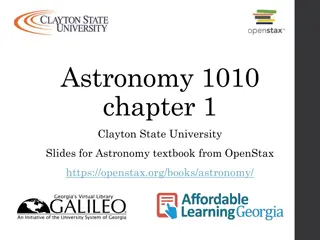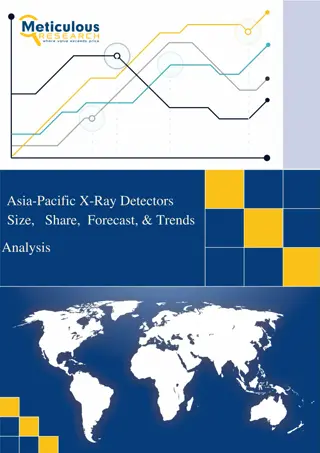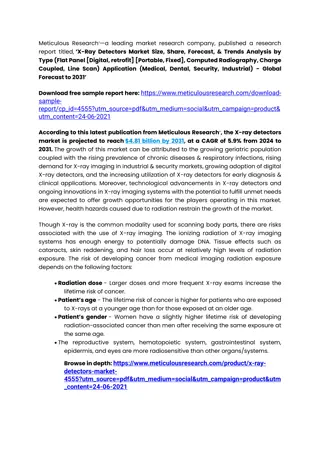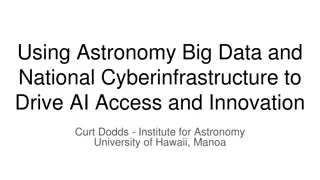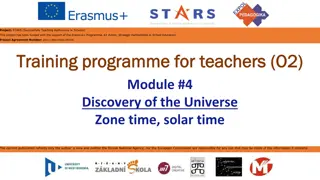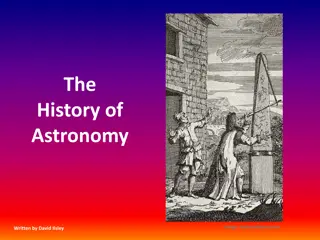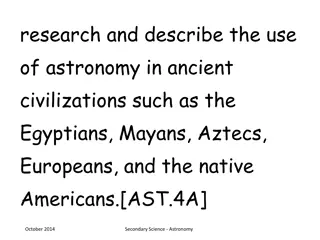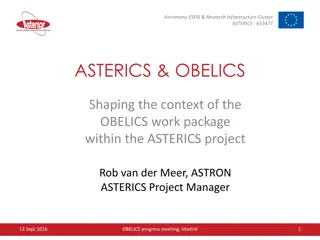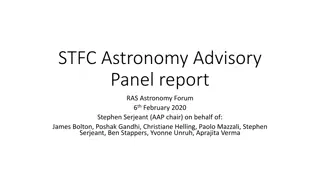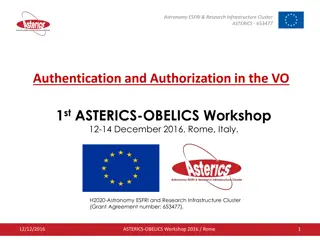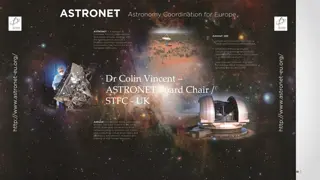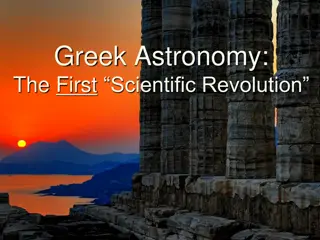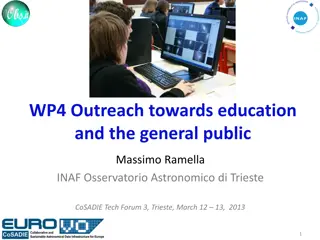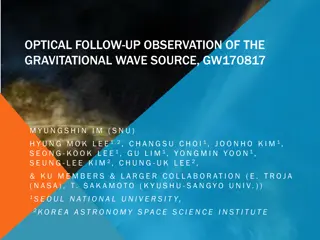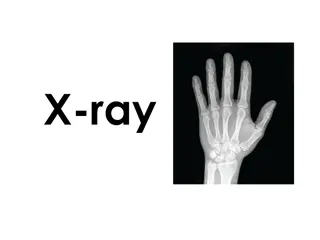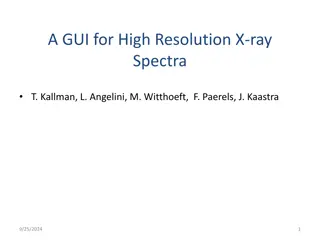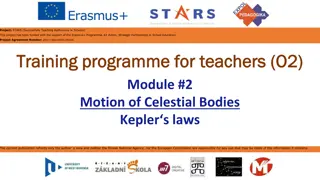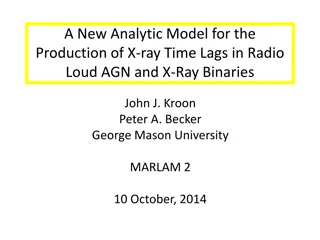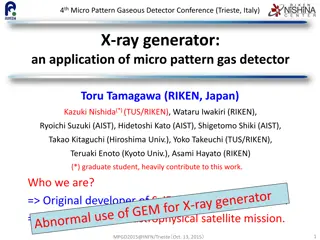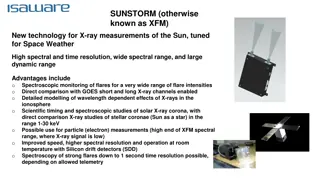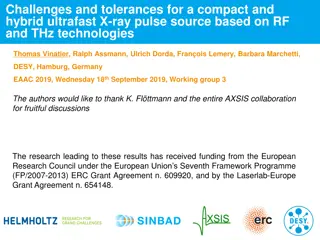X-ray Diffraction and Crystallography Safety Training Overview
X-ray diffraction and crystallography involve the use of ionizing electromagnetic radiation, specifically X-rays, which pose health risks if not handled properly. This training covers principles of X-ray safety, the importance of shielding materials like lead, steel, and concrete, X-ray production m
3 views • 44 slides
Understanding the Components of an X-Ray Machine
An X-ray machine consists of vital components like the x-ray tube, power supply, cathode, and anode. The x-ray tube houses the cathode and anode, which are responsible for generating x-rays. The cathode includes a filament heated to emit electrons, while the anode has a target to convert electron en
5 views • 22 slides
Introduction to Astronomy: Exploring the Universe and Scientific Method
Distant galaxies, the oldest science of astronomy, and the scientific method are explored in this content. Astronomy delves into the study of objects beyond Earth, while the scientific method serves as a tool to understand nature through observations and experiments.
6 views • 10 slides
asia pacific x ray detecter
X-ray detectors are devices or systems used to capture and record X-ray images for medical, industrial, scientific, or security purposes. They are essential tools for visualizing the internal structures of objects and organisms through the use of X-ray radiation. X-ray detectors are used in a variet
1 views • 3 slides
xray detecter
X-ray detectors are devices or systems used to capture and record X-ray images for medical, industrial, scientific, or security purposes. They are essential tools for visualizing the internal structures of objects and organisms through the use of X-ray radiation. X-ray detectors are used in a variet
1 views • 2 slides
Understanding X-Ray Radiation: A Comprehensive Overview
X-ray radiation, discovered by Wilhelm Conrad Roentgen in 1895, is a high-energy electromagnetic radiation with a frequency range of 3.10^16Hz to 3.10^19Hz and a corresponding wavelength range from 0.01nm to 10nm. This form of radiation has applications in various fields, and its properties make it
0 views • 15 slides
Understanding X-Ray Production and Interactions in Radiology
Explore the fundamentals of X-ray production, including the types of ionizing radiation and interactions of photons with matter. Learn about the photoelectric effect, Compton effect, and characteristics of X-ray tubes, essential for radiology professionals and students. Delve into the mechanisms beh
0 views • 17 slides
Troubleshooting Today's X-ray Systems by John DiPasquale
Gain insights into troubleshooting modern X-ray systems with a comprehensive guide presented by John DiPasquale. Explore X-ray system subsystems, including generator systems and imaging systems, with detailed explanations and visuals. Learn about the basics of generator systems, required circuits, a
1 views • 33 slides
Understanding Soft Gamma-Ray Emissions from Pulsar Polar Caps
Soft gamma-ray emissions from the polar cap cascade region are a subject of interest in astrophysics, with studies focusing on the fundamental physical processes of pulsars and potential origins of non-thermal X-ray emissions. Researchers explore the emission processes, polar cap accelerators, casca
0 views • 16 slides
Linking Soft-Ray Pulsar and Fermi LAT Pulsar Populations
This research presentation explores the connection between the soft-ray pulsar population and the Fermi LAT pulsar population, focusing on observational data and methodologies for increasing the sample size to enhance our understanding of high-energy pulsars. The study outlines the identification pr
0 views • 13 slides
Exploring Astronomy Big Data and Cyberinfrastructure for AI Innovation
Harnessing the power of big data in astronomy, this presentation by Curt Dodds from the Institute for Astronomy at the University of Hawaii, Manoa, delves into the utilization of national cyberinfrastructure to advance artificial intelligence access and foster innovation in the field. The discussion
0 views • 40 slides
Exploring Cosmic Ray Sources Using Gamma-Ray Emission Data
This study focuses on investigating ultrahigh energy cosmic ray (UHECR) sources by analyzing extragalactic diffuse gamma-ray emission data. Techniques such as examining UHECR mass composition and arrival directions, as well as studying interactions with cosmic microwave and extragalactic background
0 views • 16 slides
Overview of Observational Techniques and Student Talks in Astronomy
This content covers observational techniques, student talks, and dates related to various astronomical topics such as gamma-ray astronomy, basics of gamma-ray interaction, scintillators and solid-state detectors, Compton telescopes, and pair telescopes. It provides insights into the main processes i
0 views • 23 slides
Exploring X-Ray Emission from Galaxies by Marat Gilfanov
In this collection of images and discussions from the XMM Workshop 2010, Marat Gilfanov and collaborators delve into the study of X-ray emissions from galaxies. They investigate the properties of galaxies, stellar mass correlations, and the formation and evolution of X-ray binaries. The presentation
0 views • 35 slides
Innovating Astronomy Education at NAU Through Indigenous Perspectives
Explore how Northern Arizona University is reshaping astronomy education using innovative teaching styles with a focus on Indigenous Astronomy. Gain insights into effective teaching methods, the importance of Indigenous Astronomy lab content, teaching approaches, and creating engaging lab materials.
0 views • 7 slides
Exploring the Universe: X-Ray Surveys with Space Observatory
Delve into the fascinating world of X-ray surveys conducted by the Space Observatory at Khyung Hee University. Learn about the significance of X-ray surveys in detecting emission from hot regions of the Universe, minimizing errors in redshift measurements, extending the sample to higher redshifts, a
0 views • 16 slides
STARS Project - Teaching Astronomy in Schools
The STARS (Successfully Teaching AstRonomy in Schools) Project, funded by Erasmus+ Programme, aims to provide innovative astronomy education resources for teachers through a training program and online platform. With modules covering topics from constellations to observatories, the project offers th
0 views • 27 slides
The History of Astronomy: From Ancient Wonder to Modern Science
Astronomy, the oldest science, has fascinated humanity for millennia. From early interpretations of celestial bodies as gods to the development of instruments in Mesopotamia to predict events like eclipses, the evolution of astronomy is rich and diverse. Aristotle's theories on the cosmos laid the f
0 views • 25 slides
Ancient Astronomy and Modern Contributions
Explore the use of astronomy in ancient civilizations like the Egyptians, Mayans, Aztecs, Europeans, and Native Americans, along with the historical origins of constellations and their role in navigation. Delve into the contributions of scientists such as Ptolemy, Copernicus, Galileo, and more, and
0 views • 46 slides
Advancing Astronomy Research with ASTERICS Project
The ASTERICS project, part of the Astronomy ESFRI Research Infrastructure Cluster, aims to enhance collaboration among astronomy, astrophysics, and particle astrophysics communities. By managing and exploiting large datasets through a Virtual Observatory framework, ASTERICS facilitates new scientifi
0 views • 11 slides
Insights into AAP Priority Projects for Astronomy Advancements
The STFC Astronomy Advisory Panel's reports discuss Priority Projects focusing on innovative ideas in astronomy, such as new telescopes, receiver systems, and radio astronomy proposals. The panel aims to cover a broad range of interests and strengthen scientific endeavors in various areas, seeking f
0 views • 11 slides
Authentication and Authorization in Astronomy: A Deep Dive into ASTERICS
Explore the world of authentication and authorization in the field of astronomy through the lens of the ASTERICS project. Learn about the importance of verifying identities and granting access rights, the Virtual Observatory Approach, Single Sign-On standards, and Credential Delegation protocols. Di
0 views • 9 slides
Comprehensive European Astronomy Development Planning by ASTRONET
ASTRONET, a group of European funding agencies and infrastructures, coordinates all aspects of European astronomy. Established in the early 2000s with EU funding, ASTRONET focuses on long-term planning for the development of European astronomy. It has created the European Science Vision and Infrastr
1 views • 7 slides
Riccardo Giacconi's Impact on Japanese X-ray Astronomy
Riccardo Giacconi played a significant role in Japanese X-ray astronomy, influencing the first generation of X-ray astronomers in Japan and contributing to the development of X-ray telescopes. His visits and collaborations with Japanese scientists, such as Hideyo Kunieda and Yasuo Tanaka, were instr
0 views • 8 slides
Greek Astronomy: The First Scientific Revolution - A Visual Journey Through Ancient Greek Astronomy
Explore the world of ancient Greek astronomy through captivating images depicting landmarks, artifacts, and key figures such as Plato, Aristotle, Ptolemy, and Pythagoras. Discover the reasons behind the Greeks' reliance on astronomy, their contributions to science, and their rejection of mythologica
0 views • 52 slides
Consolidation of Outreach Activities in Astronomy Education
Massimo Ramella discusses various outreach activities aimed at educating the public about astronomy, including using tools like Aladin and Stellarium to explore the sky and engaging with elementary schools for educational experiences. The focus is on enhancing virtual learning practices and strategi
0 views • 13 slides
Optical Follow-Up Observation of GW170817 and GW Astronomy Milestones
Optical follow-up observations have been instrumental in studying the gravitational wave source GW170817. This event marked a significant milestone in GW astronomy, leading to Nobel prizes and advancements in astrophysical studies. The era of GW astronomy began in 2015 with the detection of GW150914
1 views • 33 slides
Understanding Ray Tracing in Computer Graphics
In the world of computer graphics, ray tracing plays a crucial role in rendering realistic images by simulating the behavior of light rays in a scene. This involves determining visibility, casting rays from a viewpoint, implementing ray tracing algorithms, computing viewing rays, calculating interse
0 views • 20 slides
Exploring X-ray Imaging Technology in Healthcare
Delve into the world of X-ray technology through captivating images showcasing X-ray machines, procedures, and the importance of getting an X-ray. Uncover the intricacies of this vital medical imaging tool and its role in diagnosing various conditions.
0 views • 6 slides
Applications and Importance of X-ray Fluorescence Spectroscopy in Analytical Chemistry
X-ray Fluorescence Spectroscopy (XRF) is a vital analytical technique used for qualitative and quantitative analysis of elements based on their X-ray emission characteristics. Dr. Uma Sharma, a Professor at Vikram University, details various X-ray analytical methods, including X-ray emission, Auger
0 views • 21 slides
Understanding Ray Tracing Techniques in Computer Graphics
Explore the fundamentals of ray tracing including recursive ray casting, ray casting vs. ray tracing, basic algorithms, shadows, reflections, refractions, and advanced illumination models like Whitted model and OpenGL's illumination model. Learn about casting rays from the eye, handling reflections
0 views • 50 slides
SAASTA AstroQuizTM 2015 National Finals - Test Your Astronomy Knowledge!
Get ready for the ultimate astronomy challenge at the SAASTA AstroQuizTM 2015 National Finals. Follow the rules, answer intriguing questions about the Milky Way, Radio Astronomy, Square Kilometer Array, planets, Earth's equator, asteroids, and space missions. Test your knowledge, compete with other
0 views • 42 slides
Developing a Graphical User Interface for High-Resolution X-ray Spectra Analysis
High-resolution X-ray spectra analysis can be challenging due to the complex nature of the information contained within. This project aims to simplify the process by developing a user-friendly graphical interface that enables users to visualize, analyze, and interpret X-ray spectra data effectively.
0 views • 19 slides
Project STARS: Enhancing Astronomy Education in Schools
Explore the Project STARS initiative funded by the Erasmus+ Programme, focusing on teaching astronomy in schools. This project offers training programs, methodological handbooks, online platforms, and modules covering topics like celestial bodies' motion, Newton's law of gravitation, and more. Teach
0 views • 16 slides
Efficient Parallelization Techniques for GPU Ray Tracing
Dive into the world of real-time ray tracing with part 2 of this series, focusing on parallelizing your ray tracer for optimal performance. Explore the essentials needed before GPU ray tracing, handle materials, textures, and mesh files efficiently, and understand the complexities of rendering trian
0 views • 159 slides
Analyzing X-ray Time Lags in Radio-Loud AGN and X-Ray Binaries
This research explores the production of X-ray time lags in radio-loud AGN and X-ray binaries through analytical models and simulations. It delves into the concepts of time lags, Comptonization, injection spectra, and density profiles to understand the mechanisms behind observed phenomena, such as q
0 views • 23 slides
Advancements in Triggerable X-ray Generators for Calibration in Space
The development of triggerable X-ray generators for onboard calibration devices in space is discussed, focusing on the application of micro-pattern gas detectors. The challenges and solutions for realizing triggerable X-ray generation, including the selection of electron sources and conceptual desig
0 views • 18 slides
SUNSTORM: Advanced X-ray Technology for Solar Measurements
SUNSTORM, also known as XFM, is a cutting-edge technology designed specifically for measuring X-rays from the Sun, tailored for Space Weather monitoring. It offers high spectral and time resolution, a wide spectral range, and a large dynamic range, making it ideal for various scientific studies rela
0 views • 4 slides
Understanding Ray Tracing in Computer Graphics
Explore the fascinating world of ray tracing in computer graphics through this comprehensive lecture series. From creating realism with effects like shadows, reflections, and transparency to delving into the history and evolution of ray tracing, this content covers it all. Discover the different app
0 views • 46 slides
Challenges and Tolerances for Compact Hybrid Ultrafast X-ray Pulse Source
A study on challenges and tolerances for a compact hybrid ultrafast X-ray pulse source based on RF and THz technologies was presented at EACC 2019. The research, funded by the European Research Council and Laserlab-Europe, focused on creating ultrafast X-ray pulses using S-band RF-gun, THz linac, Qu
0 views • 19 slides


